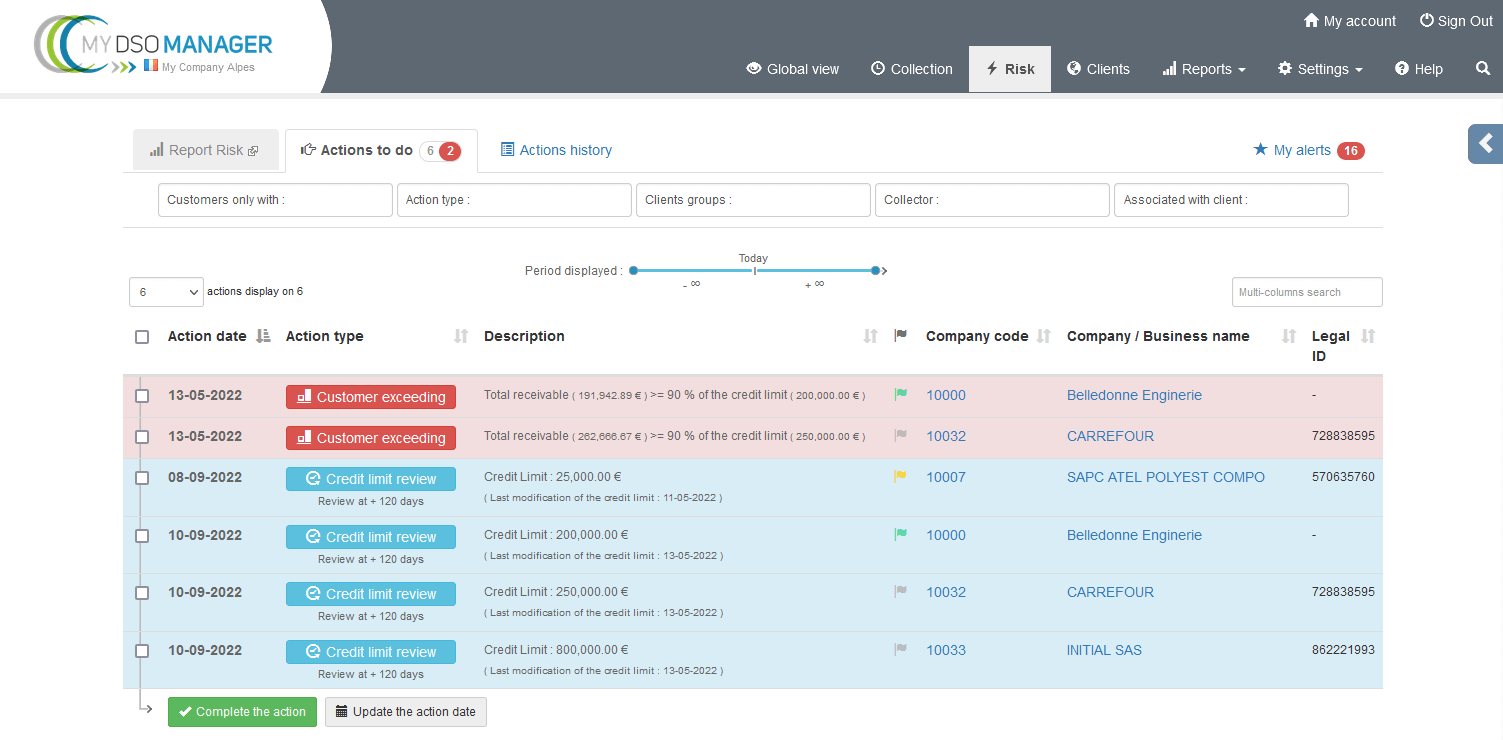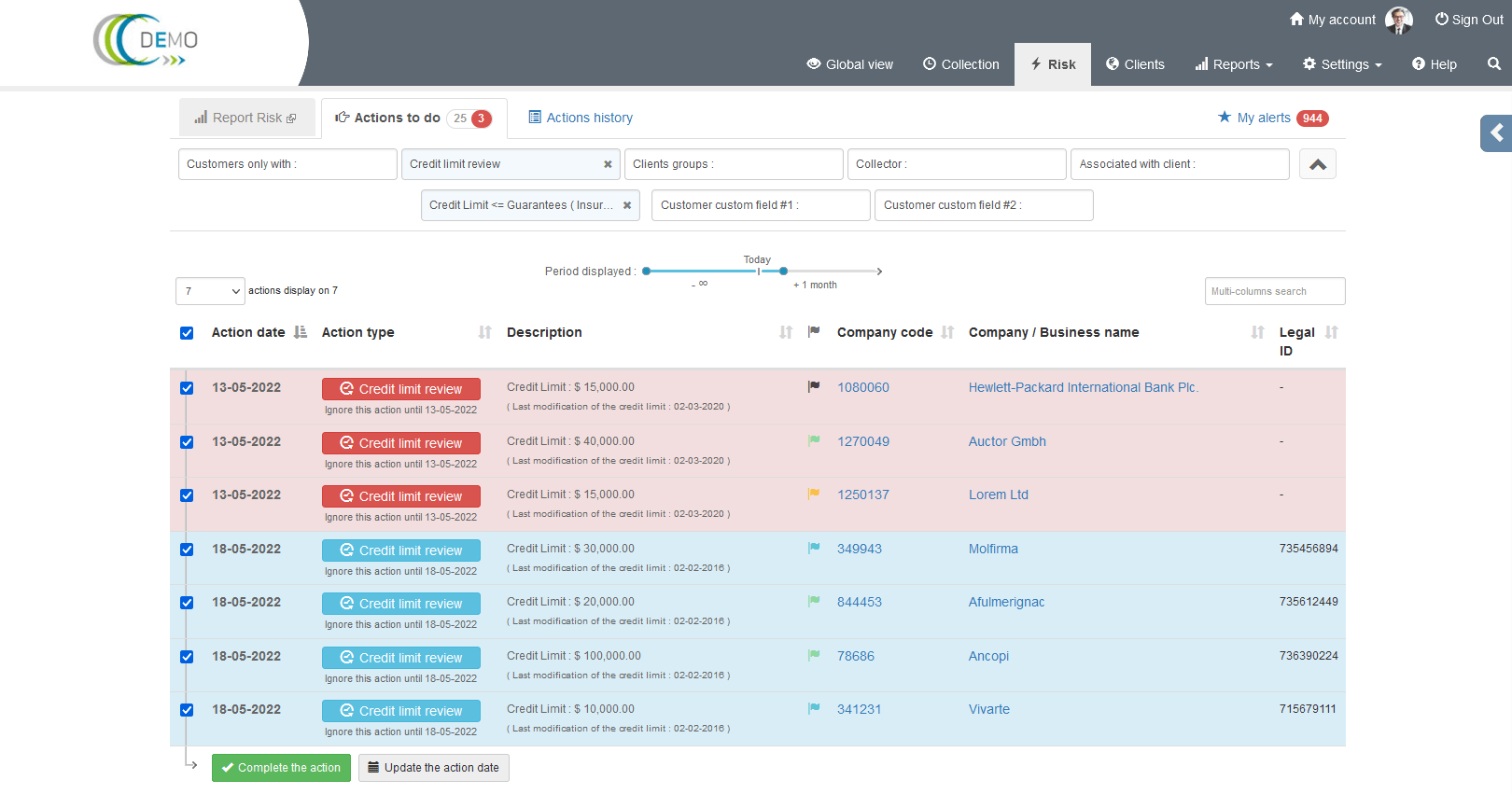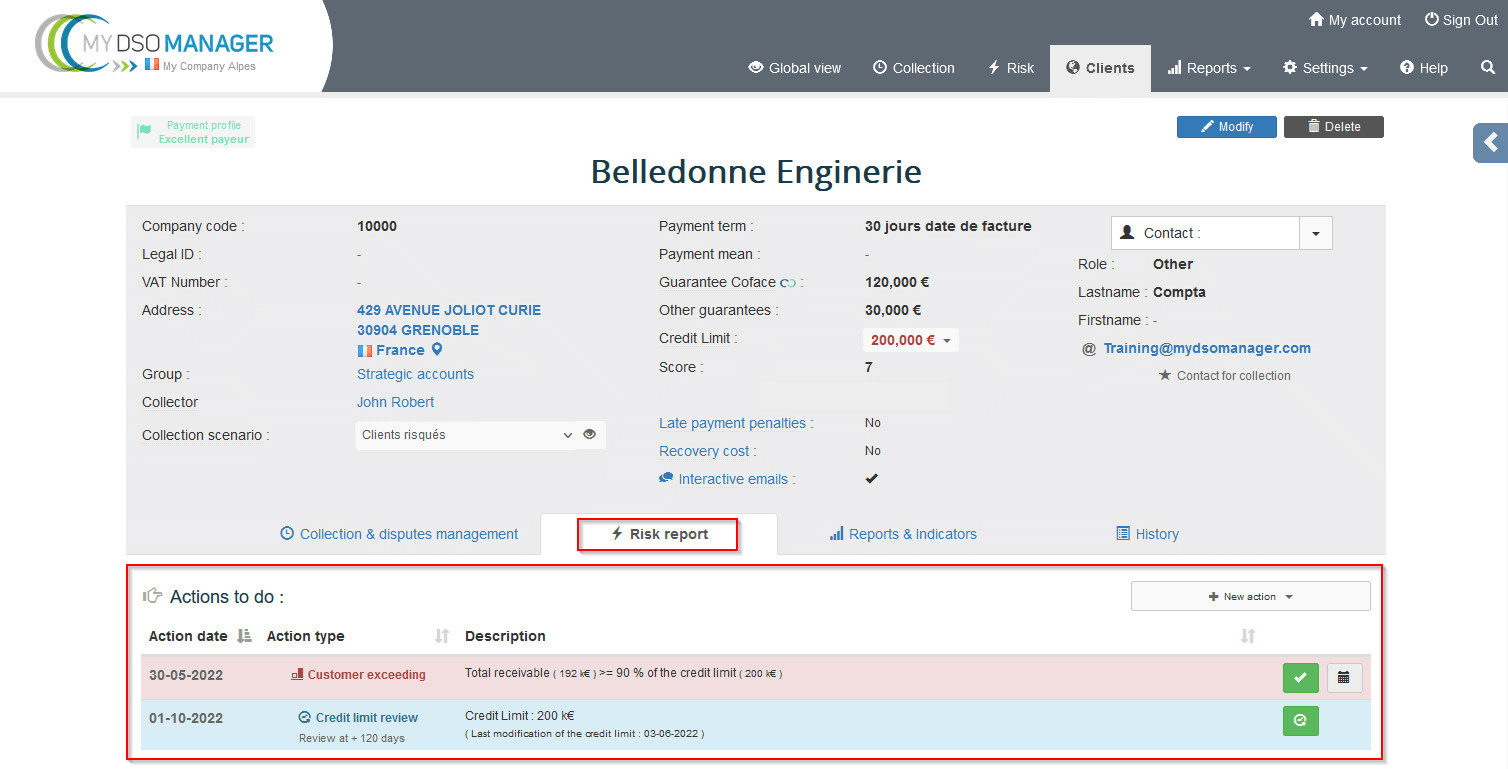Online help
Credit risk management »
How to use risk agenda?
The risk agenda allows to optimally manage customer risk by generating follow-up actions in different areas:
The objective is therefore to obtain a daily agenda with predefined actions to anticipate and control customer risk.

To automatically generate actions, simply fill in the two parameters in l'Setting / Manage risk .
.
The credit limit is the amount of outstanding receivables that you grant to a given customer. It depends on several elements such as the financial capacities of the buyer, the payment terms, the volume of business to come, the amount of credit insurance coverage, etc.
is the amount of outstanding receivables that you grant to a given customer. It depends on several elements such as the financial capacities of the buyer, the payment terms, the volume of business to come, the amount of credit insurance coverage, etc.
In the Settings set the standard validity duration of credit limits: 180 days as example. In this case, My DSO Manager will generate a credit limit review action every six months to ensure that it is still relevant and adapted to the commercial context and the financial strength of the buyer.
set the standard validity duration of credit limits: 180 days as example. In this case, My DSO Manager will generate a credit limit review action every six months to ensure that it is still relevant and adapted to the commercial context and the financial strength of the buyer.
Define the alert threshold of the outstanding level relative to the credit limit. The objective is to anticipate a possible order blockage in your ERP because the outstanding amount reaches the set limit. For example, 90%.
My DSO Manager will generate an action for any customer whose outstanding amount exceeds 90% of the credit limit, allowing you to either increase the credit limit or take action with the customer to obtain early settlement and/or reduce the time limit. payment granted.
It is possible that a large number of actions will be generated during the launch. It is therefore important to differentiate between unimportant actions, for example reviews of credit limits covered by guarantees (credit insurance, other guarantees), which can be validated en masse (see image below ), and more critical actions requiring the initiation of a credit limit validation workflow because these are not or partially covered.
We can identify three levels of actions regarding credit limits:
To do this, use the filters present in the agenda and confirm level 1 and 2 actions en masse.
Select the actions corresponding to the credit limits for which the customers have no outstanding amounts and validate them in bulk:

Select the actions corresponding to the credit limits covered by the guarantees and validate them en masse:

Next, focus on actions with unvalidated or expired credit limits using the "Credit Limits > Guarantees" filter.
Level 1 and 2 actions will come back in the future in order to refine your management of credit limits on your entire portfolio.
From the risk tab of the customer file, it is possible to create a personalized manual action by clicking on the « New action » button. It will also appear in the risk agenda.

This type of action is particularly useful when a tailor-made follow-up is required: risky or high-stakes client.
For example, the client will publish his financial statements in two months and you want to have an action in the calendar reminding you to contact him and analyze the data.
Another example, you must follow up on an unpaid debt with a collection company to which you have entrusted the file, a point with your credit insurer, or even a planned exchange with the judicial administrator who follows up a client in bankrupt, etc.
- Credit limit review
- Customer exceeding: alert when total outstanding reaches xx% of credit limit
- Custom action created by the user.
This functionality complementary to the risk report and to other functionalities such as the credit limit validation workflow, alerts, connectors with credit insurers and financial information providers, etc., will be enriched over time with new new types of actions.
The objective is therefore to obtain a daily agenda with predefined actions to anticipate and control customer risk.

How to start in the risk agenda?
To automatically generate actions, simply fill in the two parameters in l'Setting / Manage risk
Credit limit review
The credit limit
In the Settings
If you use the Link credit limit validation workflow, it may be necessary to re-validate the credit limit at each due date, in particular for customers whose guarantees obtained (credit insurance, other guarantees) do not cover the amount of the credit limit. credit.workflow de validation des limites de crédit .
.
The standard validity period of the credit limit can be customized when requesting validation. This allows you to set a temporary credit limit, for example 60 days, for a risky customer who needs to be reviewed frequently.
Exceeding customers
Define the alert threshold of the outstanding level relative to the credit limit. The objective is to anticipate a possible order blockage in your ERP because the outstanding amount reaches the set limit. For example, 90%.
My DSO Manager will generate an action for any customer whose outstanding amount exceeds 90% of the credit limit, allowing you to either increase the credit limit or take action with the customer to obtain early settlement and/or reduce the time limit. payment granted.
Once this action has been completed, it may be proposed again in 30 days unless you set another deadline when validating the action.
Starting strategy to adopt
It is possible that a large number of actions will be generated during the launch. It is therefore important to differentiate between unimportant actions, for example reviews of credit limits covered by guarantees (credit insurance, other guarantees), which can be validated en masse (see image below ), and more critical actions requiring the initiation of a credit limit validation workflow because these are not or partially covered.
We can identify three levels of actions regarding credit limits:
- Level 1: customers with a credit limit but no outstanding receivables.
- Level 2: those who have a credit limit whose amount is « covered » by the guarantees obtained.
- Level 3: those whose credit limit is greater than the guarantees obtained.
At the start, we advise you to prioritize level 3 actions and postpone by validating those of level 1 and 2. This makes it possible to start on the big stakes and then to deal with the lower stakes, without being drowned under the number of actions.
To do this, use the filters present in the agenda and confirm level 1 and 2 actions en masse.
Select the actions corresponding to the credit limits for which the customers have no outstanding amounts and validate them in bulk:

Select the actions corresponding to the credit limits covered by the guarantees and validate them en masse:

Next, focus on actions with unvalidated or expired credit limits using the "Credit Limits > Guarantees" filter.
Level 1 and 2 actions will come back in the future in order to refine your management of credit limits on your entire portfolio.
At first, prioritize high-stakes actions. My DSO Manager makes it possible to carry out reviews of credit limits or overruns of authorized outstandings on all buyers, which often represents a large volume, but also to zoom in on customers where the risk is marked, by filtering on the outstandings not covered and/or corresponding to categories of customers considered as risky. Do not hesitate to create a group of « risky » customers in order to be able to filter your risk agenda according to this data.
Manual action
From the risk tab of the customer file, it is possible to create a personalized manual action by clicking on the « New action » button. It will also appear in the risk agenda.

This type of action is particularly useful when a tailor-made follow-up is required: risky or high-stakes client.
For example, the client will publish his financial statements in two months and you want to have an action in the calendar reminding you to contact him and analyze the data.
Another example, you must follow up on an unpaid debt with a collection company to which you have entrusted the file, a point with your credit insurer, or even a planned exchange with the judicial administrator who follows up a client in bankrupt, etc.
You can also send an email about the customer risk to a sales representative or a credit insurance broker here, for example, for a request for insistence. Feel free to create one or more email templates dedicated to risk management in the Settings .
.
← Back : Online help » Various questions